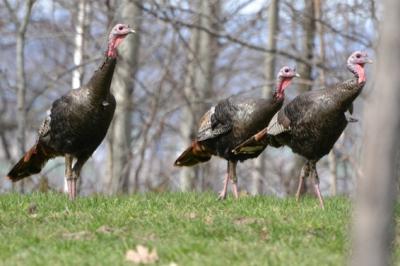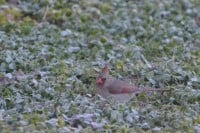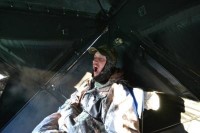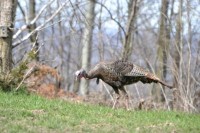“Hope springs eternal…” is a quote surely written by a turkey hunter. Optimism, along with a databank of memories, is about all that can keep you going strong after the kind of hunt fellow IDO Hunting member Pat Howard and I had this past week. I’m not sure if it’s true for all turkey hunters, but I tend to take good luck with a dose of fear, knowing full-well that tough-birds can be right around the corner and the turkey-gods will eventually get even. No matter how great things seem to be going, tough weather, pressured birds, limited land, or any of a myriad of reasons can contribute to tough hunting. But tough hunting is still hunting, and if you know that’s just the way it goes sometimes, it doesn’t hurt so bad right? Well, yes and no.
Jim Spencer of Turkey and Turkey Hunting fame has a column and now a full-blown book that he wrote on “Bad Birds.” You know the type. The kind that get under your skin. The ones that defy turkey hunting logic (ours anyway), and do exactly what they’re not supposed to do 100% of the time, only to have you “zag” when he goes back and “zigs.” So it was on Wednesday morning that we got 80 yards below a roosted tom, on the edge of a clover food plot that Pat has been monitoring with trail cameras. This bird has been in the clover plot solid, and he even started gobbling early for us around 4:55AM. To make matters better, my soft tree yelps were met with immediate irritation by a hen next door whose first words in the tree were some of the nastiest cutts I’ve heard the female turkey ever make. Surely being positioned between a vocal hen, and a vocal gobbler, in a beautiful landing zone, sitting against the edge of a plot he favors means instant death right? Cue Satan’s fowl.
For the next 2 days, this bird had our number. After flying down away from both myself and the hen, he later rejoined with another group of birds below us, then came up and around our setup on the other side of a hill we were positioned on. We got him talking, even got him coming to just behind the blind and the hill at about 80 yards. But he never showed up. Never walked the mowed trail he’s walked 100 times before, and never was quite right from that moment forward. He wouldn’t gobble, he wouldn’t move, and calling was banned from the woods. We reconnected with him later in the day, when he was feeding in the adjacent foodplot away from us, and when trying to get into position to call, he spotted us through dense brush at 200 yards while we were crawling to setup. Did I mention he was facing and feeding away from us? Ridiculous. We’d get him the next day by-Jones. Just setup on that same field, below where he walked up to roost. He’d be there in the morning and we’d whack him (regrettably) deer-hunting style.
So we did just that, and he walked within 70 yards at 9AM. This is the point where you call at him right? Only if you want him to walk further and faster the other direction. We then watched him walk into the clover plot where we should have been sitting, though I’m sure he would’ve seen us in the blind with his thermal sensing and x-ray vision. Later in the day, we made contact with him and 3 jakes he liked to beat up on. Despite the terribly open woods, and noisy sneaking conditions, we were granted a small morsel of good luck, in the form of spotting him before he spotted us. 100 yards or less, and he was actively chasing those jakes everywhere. The jakes would jake-yelp and cluck a bit at us, but our bird split in a big way. By this time, we were pretty frustrated with the fact that he was the only bird we could find, and then it didn’t matter. Must be my calling. On all of my calls. And Pat’s calling. And we were calling too loud. And too soft. With too much rasp. And not enough rasp. It didn’t matter, this boy was having none of it. We pulled the plug on him and hunted the next morning in a different location, knowing full well we could probably sit in the clover plot silent and motionless in a blind and likely kill that bird. Sounds interesting, but I don’t hunt in the spring to hunt like I do in the fall. If I’m going to hunt them like deer, I might as well just hunt deer. The birds at the other property were much the same, hammer you on the roost, then die back after fly-down…..with the exception of two very lonesome and killable birds on an adjacent property. We were able to get them to move 200 yards in our direction, gobbling at everything, but in the end, we ran out of land, and they wouldn’t cross a brushy fenceline no matter how much they gobbled. Maybe it was the bull in the pasture we stared down at 70 yards at 5AM that had them second-guessing which decision to make?
Bird numbers are down, undeniably, even based on anecdotal evidence of less sightings, fewer gobbling, and less overall activity; but that’s no excuse. This reminded me of a good old fashioned pressured public land hunt, late season Missouri. Where birds hear it all, see it all, and refuse to play the game the way we all like to see it played. You need to get creative, make use of your windows of opportunity, and revert to tactics that rely more on woodsmanship than calling ability. You also need more than 2 ½ days, but that’s just the way it goes. It’s not the first time I’ve been whipped turkey hunting, and it certainly won’t be the last. I have to admit, though I’ve seen some pretty low lows while turkey hunting, morale was dropping fast and it was all I could do to stay out there the full days without a break like we were to try and strike a willing bird. Multiple jakes came in, even an opportunity at a bearded hen presented itself, but we had loftier goals than the turkeys would allow at least this time. It certainly makes tagging a tom that much more worthwhile when the clouds part and rain down turkeys in every woodlot you check. And, while the thought of slower than usual hunting can weigh on you mentally, always keep in mind that your bird is just around the corner. I’ve seen luck, conditions, and the entire season turn on a dime too many times to be completely despondent, and I’ve hunted harder and much longer for far less without giving up. Why stop now? Such is the life of a turkey hunter, and yes, there is a Wisconsin Report – Part 2, and hope does spring eternal for a turkey hunter. It simply has to.
Joel




Even though it didn’t include a kill, it’s one if the best turkey reports that I’ve ever read. I guess I personally think and learn more about the turkey hunts that were unsuccessful versus the ones when I killed. If it was easy – I’m guessing we wouldn’t be so passionate about it.
I guess I personally think and learn more about the turkey hunts that were unsuccessful versus the ones when I killed. If it was easy – I’m guessing we wouldn’t be so passionate about it.
It has been a strange year for turkey’s to say the least. I’m not sure it’s because of fewer turkey’s as it’s there changing patterns. Field birds are now timber birds. We are having a hard time finding birds because they are doing there thing inside the wood line rather than in the fields. But when you talk to the local farmers they say the birds are everywhere.
Great read Joel as usual…all we can do is continue to give it our best shot and hopefully lady luck will shine on us one more time.
Awesome report Joel can’t wait for part 2
can’t wait for part 2 
great read, joel.


more proof that theres a heck of a lot more to turkey hunting – or any hunting – than squeezing the trigger.
i got a feeling part 2 might have a happy ending.
Got lots of pics of this guy outside our blind that week.
Great picture Joel…very sharp photo!
Great report Joel and it sounds like you and Pat had fun anyway ! That’s what the hunt is all about
Thanks for coming over and being punished with me Joel

Awesome write up bud !!!!!!